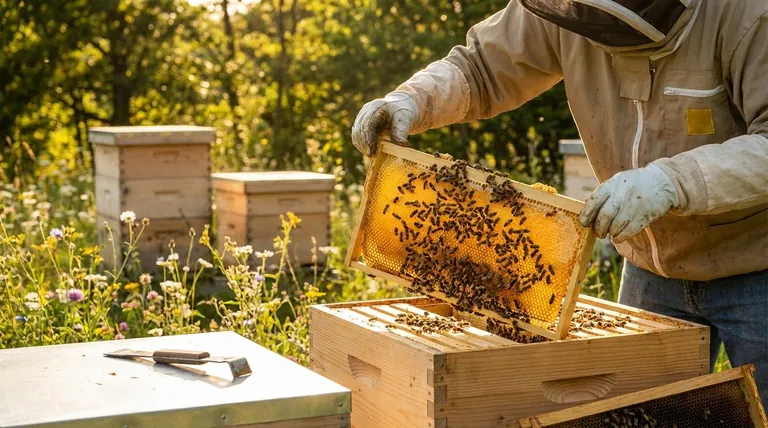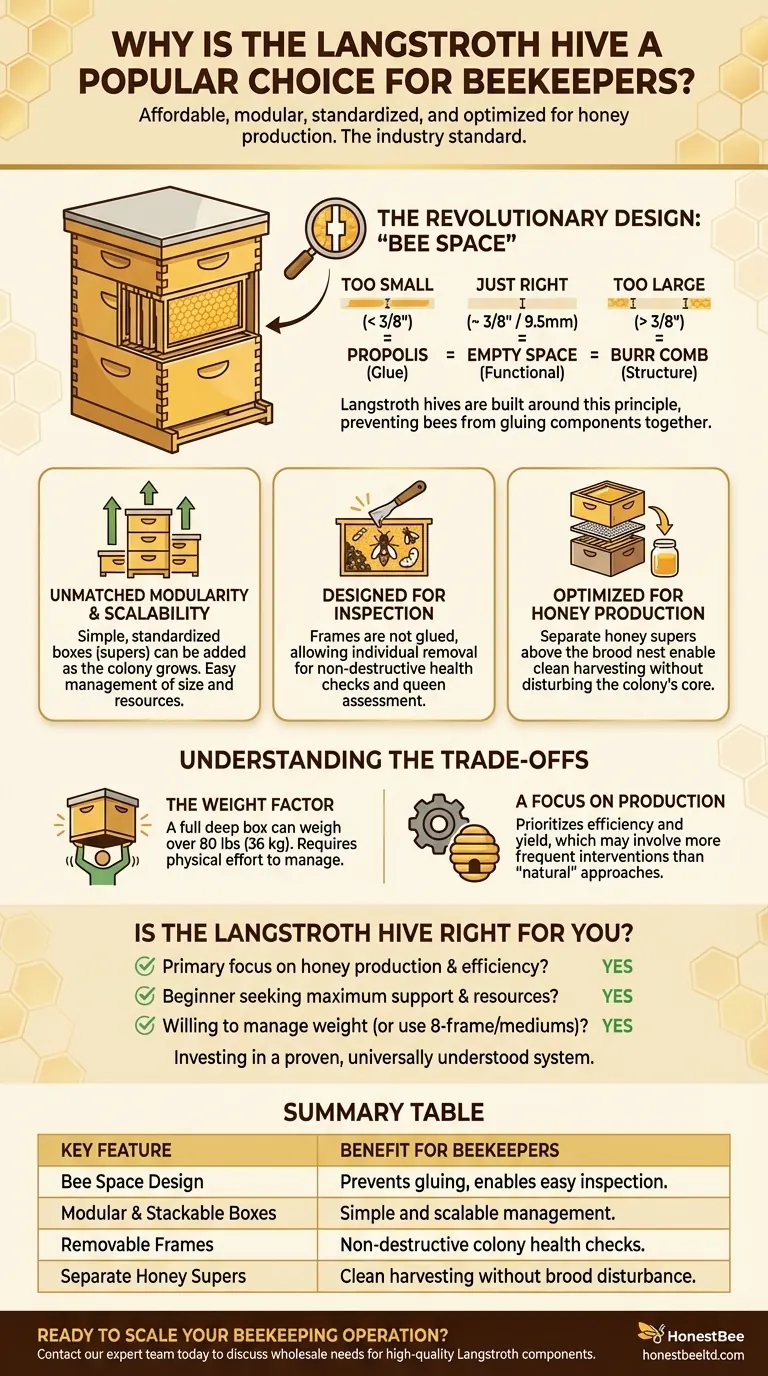At its core, the Langstroth hive is overwhelmingly popular because it is an affordable, modular system with widely available parts that is optimized for honey production. Its standardization means there is a vast ecosystem of compatible equipment and an enormous amount of educational support for beekeepers at every level.
The Langstroth hive's dominance is not just about its low cost or availability. Its success stems from a revolutionary design that allows beekeepers to inspect and manage the colony with minimal disruption, promoting bee health and maximizing honey yield.

The Design That Changed Beekeeping
The brilliance of the Langstroth hive lies in a single, crucial discovery by its inventor, Reverend Lorenzo Langstroth: the concept of "bee space."
Understanding "Bee Space"
Langstroth observed that bees will leave a space of approximately 3/8 of an inch (about 9.5 mm) empty. If a gap is smaller, they fill it with propolis (a resinous glue); if it's larger, they build comb in it.
The Langstroth hive is precisely built around this principle. Every frame is spaced to maintain this gap, preventing bees from gluing the frames to the hive body or to each other.
This single design choice makes the entire system functional and is the root of its major advantages.
Key Advantages of the Langstroth System
The adherence to "bee space" creates a hive that is easy to work with, scalable, and highly productive.
Unmatched Modularity and Scalability
The hive consists of simple, standardized, and stackable boxes. This allows the beekeeper to easily expand the hive's volume as the colony grows and the honey flow begins.
When a box becomes about 70% full of bees, comb, and resources, another box can simply be added on top. This makes managing colony size straightforward and efficient.
Designed for Inspection and Management
Because the frames are not glued in place, they can be removed individually for inspection. A hive tool is essential for this, used to gently pry apart components that bees have sealed with a light amount of propolis.
This inspectability is critical. It allows beekeepers to check the queen's health, look for signs of disease or pests, and assess food stores without destroying the bees' intricate comb structure.
Optimized for Honey Production
The modular design allows beekeepers to add boxes, known as honey supers, specifically for honey storage. These are typically placed above the main brood chambers where the queen lays eggs.
This separation makes harvesting much cleaner. The beekeeper can remove frames full of honey from the supers while leaving the colony's essential brood and food stores undisturbed below.
Understanding the Trade-offs
While dominant, the Langstroth design is not without its compromises. True objectivity requires acknowledging its limitations.
The Weight Factor
A standard 10-frame "deep" Langstroth box, when full of honey, brood, and pollen, can weigh over 80 pounds (36 kg). Lifting and manipulating these heavy boxes is a significant physical challenge.
A Focus on Production
The Langstroth is, first and foremost, a tool for efficient apiary management and honey production. Beekeepers prioritizing a more "natural" or less-intrusive approach may find the frequent inspections and interventions encouraged by the design to be a downside.
The Ecosystem of Standardization
The greatest strength of the Langstroth—its standardization—can also be a limitation. The vast majority of beekeeping knowledge and equipment is centered around this single design, which can stifle innovation and experimentation with other hive types.
Is the Langstroth Hive Right for You?
Choosing a hive is the first major decision for a new beekeeper. The Langstroth hive's popularity is a direct reflection of its utility for most common beekeeping goals.
- If your primary focus is honey production and operational efficiency: The Langstroth hive is the undisputed industry standard for a reason.
- If you are a beginner seeking maximum support: The sheer volume of books, online courses, and local mentors familiar with the Langstroth is unmatched.
- If you are concerned about heavy lifting: You can mitigate the weight by opting for 8-frame equipment (instead of 10-frame) or by using all "medium" depth boxes, which are lighter.
Ultimately, choosing a Langstroth hive is investing in a proven, flexible, and universally understood beekeeping system.
Summary Table:
| Key Feature | Benefit for Beekeepers |
|---|---|
| Bee Space Design | Prevents bees from gluing frames, enabling easy inspection. |
| Modular & Stackable Boxes | Simple and scalable management as the colony grows. |
| Removable Frames | Allows for non-destructive colony health checks and management. |
| Separate Honey Supers | Enables clean honey harvesting without disturbing the brood nest. |
Ready to scale your beekeeping operation with the industry-standard Langstroth hive?
As a trusted wholesale supplier, HONESTBEE provides commercial apiaries and beekeeping equipment distributors with high-quality, durable Langstroth hive components and essential beekeeping tools. Our equipment is designed for efficiency, durability, and maximum honey yield.
Contact our expert team today to discuss your wholesale needs and discover how our supplies can help you build a more productive and manageable apiary.
Visual Guide

Related Products
- Langstroth Bee Hives Bee Keeping Box for Beginners Beekeeping
- Long Langstroth Style Horizontal Top Bar Hive for Wholesale
- HONESTBEE Advanced Ergonomic Stainless Steel Hive Tool for Beekeeping
- HONESTBEE Professional Long Handled Hive Tool with Precision Cutting Blade
- Professional Dual-End Stainless Steel Hive Tool for Beekeeping
People Also Ask
- What is the best type of bee hive for beginners? Start with the Proven Langstroth Standard
- What basic equipment is needed to start beekeeping? Your Essential Guide to a Confident Start
- Should a beginner try a different type of hive? Start with a Langstroth for a solid foundation.
- How does the ease of access differ between 8-frame and 10-frame hives? Choose the Right Hive for Your Body
- Why are Langstroth hives recommended for beginners? Unmatched Support & Standardization



















